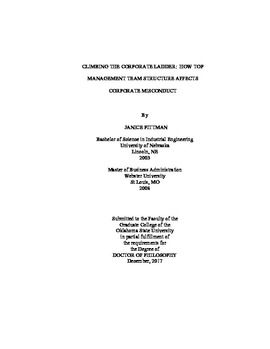| dc.contributor.advisor | White, Margaret A. | |
| dc.contributor.author | Pittman, Janice | |
| dc.date.accessioned | 2018-06-25T13:38:27Z | |
| dc.date.available | 2018-06-25T13:38:27Z | |
| dc.date.issued | 2017-12 | |
| dc.identifier.uri | https://hdl.handle.net/11244/300260 | |
| dc.description.abstract | To bolster the possibility of becoming the next CEO, the heir apparent of a corporation has both a level of expectancy and motivation to reduce corporate misconduct. Studies that examine the relationship between corporate misconduct and the succession of the heir apparent are limited. As such, this study examines how the expectancy of the heir apparent to become CEO influences the motivation of the heir to minimize corporate misconduct. The study's finding suggests pay gap correlates with levels of misconduct. This study contributes to the strategic management literature by advancing corporate misconduct research beyond examining financial misrepresentation to examining the influence of organizational structure on corporate misconduct. | |
| dc.format | application/pdf | |
| dc.language | en_US | |
| dc.rights | Copyright is held by the author who has granted the Oklahoma State University Library the non-exclusive right to share this material in its institutional repository. Contact Digital Library Services at lib-dls@okstate.edu or 405-744-9161 for the permission policy on the use, reproduction or distribution of this material. | |
| dc.title | Climbing the corporate ladder: How top management team structure affects corporate misconduct | |
| dc.contributor.committeeMember | Webb, Richard Edward | |
| dc.contributor.committeeMember | Sarathy, Rathin | |
| dc.contributor.committeeMember | Ridge, Jason | |
| osu.filename | Pittman_okstate_0664D_15421.pdf | |
| osu.accesstype | Open Access | |
| dc.type.genre | Dissertation | |
| dc.type.material | Text | |
| thesis.degree.discipline | Business Administration | |
| thesis.degree.grantor | Oklahoma State University | |
